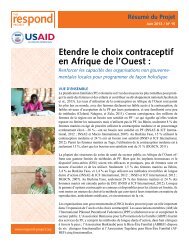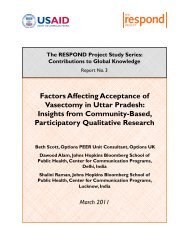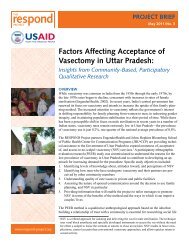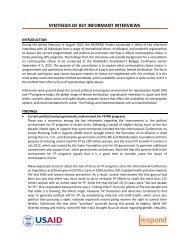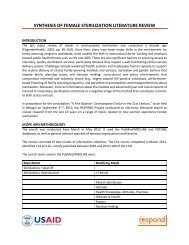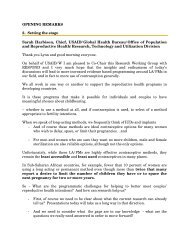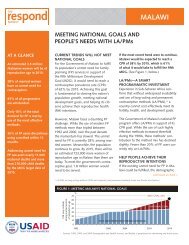Community-Based Distribution of Misoprostol for the Prevention of ...
Community-Based Distribution of Misoprostol for the Prevention of ...
Community-Based Distribution of Misoprostol for the Prevention of ...
Create successful ePaper yourself
Turn your PDF publications into a flip-book with our unique Google optimized e-Paper software.
The one-day orientation was useful as a strategy to orient <strong>the</strong> district- and upazila-level managers and<br />
facility-based service providers be<strong>for</strong>e intervention started. This orientation helped to involve <strong>the</strong> managers<br />
in implementing and monitoring <strong>the</strong> program activities and increased awareness among facility-based service<br />
providers about <strong>the</strong> technical issues <strong>of</strong> misoprostol and how to manage complications. Some service providers<br />
raised concerns about increasing <strong>the</strong> duration <strong>of</strong> <strong>the</strong> orientation. Considering <strong>the</strong> contents <strong>of</strong> <strong>the</strong>ir orientation,<br />
<strong>the</strong> evaluation team believes that one day is enough to ensure that program managers fully in<strong>for</strong>m <strong>the</strong> service<br />
providers about misoprostol and <strong>the</strong>ir responsibilities in managing any complications. Any questions that<br />
service providers may have after <strong>the</strong> training can be handled by <strong>the</strong> program managers during monitoring and<br />
supervision.<br />
Analysis <strong>of</strong> <strong>the</strong> contents <strong>of</strong> <strong>the</strong> training manual, <strong>the</strong> flipchart, and <strong>the</strong> leaflet found that <strong>the</strong>se are excellent<br />
materials <strong>for</strong> a community-level intervention. As a result <strong>of</strong> <strong>the</strong> communication ef<strong>for</strong>ts and clear instructions<br />
provided in <strong>the</strong> materials and in <strong>the</strong> training, <strong>the</strong> use compliance <strong>for</strong> misoprostol tablets was very high. Users<br />
found <strong>the</strong> pictorial contents <strong>of</strong> <strong>the</strong> BCC materials very useful to <strong>the</strong>m, in particular <strong>the</strong> materials in which<br />
pictures reminded <strong>the</strong>m when and how to take <strong>the</strong> misoprostol tablets. However, although <strong>the</strong> training manual<br />
and leaflet clearly state that “<strong>Misoprostol</strong> tablets should be taken if both baby and placenta come out toge<strong>the</strong>r<br />
as well,” it is not mentioned clearly ei<strong>the</strong>r in <strong>the</strong> training manual or in <strong>the</strong> leaflet what should be done if women<br />
have delayed placental expulsion (i.e., retained placenta). In <strong>the</strong> training manual and on <strong>the</strong> flipchart, leaflets,<br />
and stickers, it is mentioned that misoprostol should be taken immediately after delivery <strong>of</strong> <strong>the</strong> baby, after<br />
ensuring that no additional baby is in <strong>the</strong> womb. Although it implies that <strong>the</strong> drug should be taken immediately<br />
after delivery <strong>of</strong> <strong>the</strong> baby and be<strong>for</strong>e <strong>the</strong> delivery <strong>of</strong> placenta, this is not mentioned clearly. As such, it was<br />
found that this created some confusion among some pregnant women and <strong>the</strong>ir attendants. The evaluation<br />
team suggests stating this more clearly when <strong>the</strong> BCC materials are revised.<br />
A number <strong>of</strong> misconceptions about postdelivery bleeding are prevalent in <strong>the</strong> community. For example,<br />
women called postdelivery bleeding “bad blood” or said “it is an accumulation <strong>of</strong> menstrual blood <strong>of</strong> 10<br />
months,” and <strong>the</strong>y have heard or believe such misconceptions as <strong>the</strong> following: “If more blood goes out, it<br />
clears <strong>the</strong> abdomen”; “if <strong>the</strong>re is reduced bleeding, it will cause pain in <strong>the</strong> body”; “excessive bleeding causes<br />
tetanus”; “[<strong>the</strong>] body becomes lighter if bad blood goes out”; and/or “this is wish <strong>of</strong> Allah; this cannot be<br />
stopped.” These beliefs were common among most women interviewed. Findings from <strong>the</strong> nonusers indicated<br />
that <strong>the</strong>se misconceptions were one <strong>of</strong> <strong>the</strong> key causes <strong>for</strong> misoprostol nonuse <strong>of</strong> and should be addressed<br />
more specifically in future communication ef<strong>for</strong>ts, particularly during revision <strong>of</strong> <strong>the</strong> leaflets, and should be<br />
incorporated into <strong>the</strong> service providers’ training curriculum. Women’s misconceptions and beliefs and how to<br />
counter <strong>the</strong>m should be included in <strong>the</strong> future training curriculum <strong>for</strong> <strong>the</strong> field workers and o<strong>the</strong>r service<br />
providers.<br />
Two women in this study experienced complete cessation <strong>of</strong> bleeding after taking <strong>the</strong> misoprostol tablets<br />
following delivery. The possibility <strong>of</strong> this happening needs to be addressed during <strong>the</strong> training and orientation<br />
<strong>of</strong> field workers, supervisors, and service providers, in<strong>for</strong>ming <strong>the</strong>m that in rare cases, women may have a<br />
complete absence <strong>of</strong> bleeding or total cessation <strong>of</strong> bleeding after delivery due to taking misoprostol.<br />
Fur<strong>the</strong>rmore, <strong>the</strong> training needs to include discussion about <strong>the</strong> difference between “stopping bleeding” and<br />
“stopping excessive bleeding,” because “stopping bleeding” means complete cessation <strong>of</strong> bleeding while<br />
“stopping excessive bleeding” means that some bleeding will still occur after delivery, but it will be less.<br />
The findings suggest that <strong>the</strong> description <strong>of</strong> misoprostol side effects during interpersonal communication<br />
deserves some caution and more elaboration. In addition, <strong>the</strong> “insert” developed to explain <strong>the</strong> misoprostol<br />
tablet needs review and modification. Findings suggest that a number <strong>of</strong> women did not take <strong>the</strong> tablets after<br />
hearing about side effects or reading about <strong>the</strong>m in <strong>the</strong> leaflet or <strong>the</strong> “insert” inside <strong>the</strong> packets <strong>of</strong> tablets. A<br />
balanced strategy is needed on how to explain <strong>the</strong> side effects <strong>of</strong> misoprostol to community members and<br />
pregnant women, while comparing <strong>the</strong> side effects with <strong>the</strong> consequences <strong>of</strong> PPH. Pregnant women/readers<br />
should have clear knowledge about <strong>the</strong> gravity <strong>of</strong> <strong>the</strong> side effects and <strong>the</strong> percentage <strong>of</strong> users who may suffer<br />
from each <strong>of</strong> <strong>the</strong> side effects. Since excessive postdelivery bleeding is common and life-threatening, while <strong>the</strong><br />
side effects due to misoprostol use are rare and minor, including in <strong>the</strong> insert a presentation comparing <strong>the</strong><br />
Mayer Hashi project <strong>Community</strong>-<strong>Based</strong> <strong>Distribution</strong> <strong>of</strong> <strong>Misoprostol</strong> <strong>for</strong> <strong>the</strong> <strong>Prevention</strong> <strong>of</strong> PPH 23





